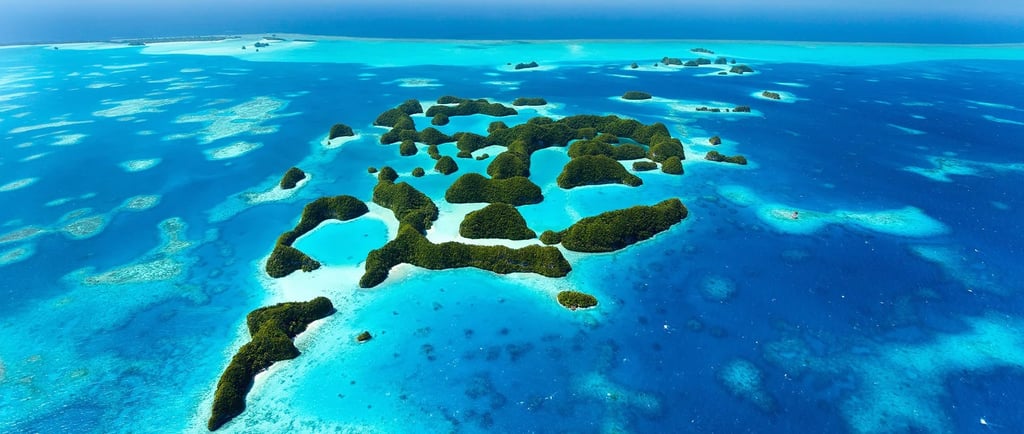Fishing licences in Pacific microstates: between financial windfall and economic dependence
OCEANIA
Thomas Dos Remedios
9/24/20256 min read


DISPROPORTIONATE MARITIME WEALTH
Oceania is made up of a mosaic of island states whose land area is tiny on a global scale, but whose maritime space is among the largest on the planet. Under the United Nations Convention on the Law of the Sea (UNCLOS, 1982), each country has an exclusive economic zone (EEZ) extending 200 nautical miles from its coastline. As a result, countries such as Kiribati (800 km² of land) control nearly 3.5 million km² of sea, an area equivalent to India.
These oceanic EEZs are rich in fishery resources, particularly tuna (yellowfin tuna, bigeye tuna, skipjack tuna), which account for more than 60% of global tropical tuna catches. This resource is strategic for the global canning industry and for supplying protein to coastal populations. However, the Pacific States themselves do not have the industrial fleets needed to exploit these resources. Lacking the technical and financial means, they therefore sell fishing licences to external powers.
A VITAL ECONOMIC WINDFALL
For most of these countries, fishing licences are a crucial financial resource. According to the World Bank, they account for an average of 40 to 60% of the budgetary revenues of Pacific microstates, and sometimes much more. In Kiribati, for example, up to 70% of the national budget comes from the sale of fishing rights to foreign fleets. In Tuvalu, this figure regularly exceeds 50%.
This revenue helps to finance essential public services such as health, education and infrastructure. It compensates for the lack of other sources of sustainable economic growth, as these countries suffer from geographical isolation, dependence on imports and climate vulnerabilities. In this context, fishing appears to be a ‘blue rent’, the equivalent for these states of what oil represents for certain Gulf countries.
But this income is unstable. It depends on external factors: changes in fish stocks, international negotiations and the willingness of major powers to respect quotas. Fluctuations in the tuna market can also directly affect the budgetary capacity of these states.
THE NAURU AGREEMENT : A TOOL FOR COLLECTIVE REGULATION
To prevent the ‘sell-off’ of their resources, eight island countries (Kiribati, Nauru, Tuvalu, Palau, the Marshall Islands, Micronesia, the Solomon Islands and Papua New Guinea) founded the Nauru Agreement Stakeholders (NAS) in 2010. This organisation set up the Vessel Day Scheme (VDS), a mechanism that sets a limited number of authorised fishing days in the region and a minimum price per day.
This system has significantly increased revenues. While in 2010 the price of a fishing day was around $1,500, today it exceeds $8,000. In ten years, the revenues of the NPA States have quadrupled. This agreement is often cited as a successful example of regional cooperation, where small countries, by joining forces, are able to exert influence over the major maritime powers.
However, this success remains fragile. External states (Japan, China, South Korea, Taiwan, United States) are exerting pressure to obtain exemptions. Foreign vessels sometimes circumvent the system by fishing in border areas, under-reporting their catches, or using controversial techniques such as fish aggregating devices (FADs), which attract schools of tuna but also capture non-target species, particularly sharks.
MAJOR POWERS STORMING THE PACIFIC
The management of ocean fish stocks is also a geopolitical issue. China, which has the world's largest distant-water fishing fleet (more than 3,000 vessels), is now the most active player in the region. Beijing is accused by several NGOs and Western governments of resorting to aggressive practices: exceeding quotas, illegal fishing, and diplomatic pressure in exchange for aid or investment.
The United States and the European Union, which consume a large proportion of the tuna caught in the Pacific, are seeking to secure their supplies while limiting Chinese influence. The United States-Pacific Islands Fisheries Agreement, signed in 1987, guarantees the Americans access rights in exchange for financial compensation and development programmes. Australia and New Zealand also support the Pacific countries, but their room for manoeuvre remains limited in the face of Asia's growing power.
This competition makes small Pacific states true strategic arbiters. Their voice is increasingly influential in international bodies, particularly the Western and Central Pacific Fisheries Commission (WCPFC). But their influence is counterbalanced by their economic dependence, which limits their freedom of action.
A RESSOURCE THREATENED BY OVERFISHING AND CLIMATE CHANGE
Beyond economic and diplomatic tensions, the ecological sustainability of the resource is a crucial issue. According to the FAO, nearly 33% of global fish stocks are overexploited, and Pacific tuna are no exception. Yellowfin and bigeye tuna are showing signs of overexploitation in certain areas.
Climate change is further exacerbating the situation. Rising ocean temperatures and changing ocean currents are shifting tuna concentrations eastwards, which could reduce the economic value of some states' EEZs. According to projections by the Pacific Community (SPC), countries such as Kiribati and Tuvalu could lose up to 40% of their fishing income by 2050 if tuna migration patterns continue.
For these microstates, the issue is not only economic: it is existential. If the resource disappears or migrates out of their waters, their main source of income will collapse, condemning them to increased dependence on international aid.
A PARADOXICAL MARITIME SOVEREIGNTY
Oceanic microstates have some of the largest maritime areas in the world, but lack the means to control or exploit them. Their maritime sovereignty is therefore paradoxical: immense on paper, fragile in reality. The sale of fishing licences provides them with much-needed income, but places them in a situation of economic dependence on the major powers.
In the long term, these countries will face a dual challenge: preserving the sustainability of their fishery resources and diversifying their economies to reduce their vulnerability. Some are already exploring new avenues, such as sustainable tourism, marine renewable energy and the exploitation of their rights to submarine cables. But for now, the sea remains their main resource, and tuna their currency of exchange in the global economy.
THE UNCERTAIN FUTURE OF OCEANIAN FISHERIES REVENUE
While fishing will still be the economic backbone of many Pacific microstates in 2025, current trends point to a much more uncertain future. Several scenarios, closely linked to climate change, geopolitical power relations and global market developments, paint a fragile future for these island nations.
The first challenge is ecological. Projections by the Pacific Community (SPC) show that by 2050, tropical tuna stocks could shift several hundred kilometres eastwards as a result of ocean warming and changing currents. In practical terms, this means that countries such as Kiribati, Tuvalu and the Marshall Islands, which currently derive more than half of their income from the sale of fishing licences, could see their catches fall by 20 to 40 per cent. Conversely, other areas closer to Latin America could benefit from this migration. This geographical redistribution would further weaken states already exposed to rising sea levels and climate disasters.
The second challenge is geopolitical. By 2050, China, which already has the world's largest distant-water fishing fleet, could dominate the Pacific even more. Beijing is investing heavily in the development of factory ships and port infrastructure diplomacy, particularly through the New Maritime Silk Roads. Faced with this, the United States, Australia and Japan will try to maintain a counterweight, but micro-island states risk being drawn into a competition that reduces their room for manoeuvre. Their ‘maritime sovereignty’ could then become a fiction, with their EEZs serving as negotiating grounds where each licence sold equates to a choice of strategic alignment.
A third challenge is economic and social. Budgetary dependence on fishing exposes these countries to a brutal shock if resources become scarce or revenues fall. The World Bank is already warning of this risk: without economic diversification, states such as Tuvalu and Nauru could see their budgets halved within a generation. To avoid this trajectory, some are banking on the development of high-end tourism, the exploitation of marine renewable energies (particularly ocean thermal energy) or the promotion of ecosystem services (international payments for biodiversity protection). But these projects remain in their infancy and are dependent on external funding.
Finally, one last challenge looms: rising sea levels. Several atolls could be partially submerged by 2050, calling into question the very legal status of EEZs. International law does not yet provide for what happens to a maritime zone if the coastal state loses part of its land territory. Can we imagine a ‘maritime state without land’? Kiribati and Tuvalu, threatened with extinction, are calling for the recognition of oceanic sovereignty independent of territory. If this idea were to prevail, these countries would continue to receive revenue from their EEZs even if their populations were exiled, but this would require a major redefinition of the law of the sea.
In short, by 2050, the micro-states of the Pacific will find themselves at a crossroads. Their future will depend on their ability to negotiate skilfully with the major powers, preserve the sustainability of their fishery resources and invent new economic models. Failing that, the ‘blue economy’ that currently ensures their survival could become a trap of dependency, condemning them to suffer the decisions of others rather than fully exercising their sovereignty.
Thomas Dos Remedios, for SPECTIO
The statements made are solely those of their authors and do not reflect the position of the Think Tank Spectio.
